本文转载自:http://blog.csdn.net/ff20081528/article/details/17353869
一、准备知识
1、视图坐标与布局坐标的区别如下图所示:
上图是一个坐标系,这个坐标系是无边无际的。这个无边无际的坐标系即视图坐标。手机屏幕可视范围内的坐标即手机屏幕的布局坐标(坐标原点是屏幕的左上方的(0,0)位置)即A点。屏幕里面的子视图里面可视范围内的坐标即子视图的布局坐标(坐标原点是子视图的左上方的(0,0)位置)即B点。
2、android中布局关系
二、例子说明事件分发过程
这里我写了一个布局文件,展示效果如上图。当我点击View1,事件的分发过程是这样的:
1、ViewGroup3的dispatchTouchEvent()方法会被调用。
2、ViewGroup3调用ViewGroup2的dispatchTouchEvent()方法。
3、ViewGroup2调用ViewGroup1的dispatchTouchEvent()方法。
4、ViewGroup1会调用View1的dispatchTouchEvent()方法。
5、View1的dispatchTouchEvent()方法调用自己的onTouchEvent()方法。在onTouchEvent方法中处理点击事件。处理完了后会返回一个true给调用它的dispatchTouchEvent()方法。
6、ViewGroup1的dispatchTouchEvent()方法会返回一个true值给ViewGroup2的dispatchTouchEvent()方法。这样一直将则个true值返回到ViewGroup3的dispatchTouchEvent()方法。ViewGroup3在将这个值返回给调用它的方法。这样一个事件分发过程结束。
三、ViewGroup中处理消息的详细过程
通过上面的列子对事件分发的过程有个大概的了解之后,我们通过ViewGroup中的dispatchTouchEvent()方法源码和View中的dispatchTouchEvent()方法及touchEvent方法源码来详细了解android是怎样处理这个过程的。
ViewGroup中的dispatchTouchEvent()方法源码如下:
@Override
public boolean dispatchTouchEvent(MotionEvent ev) {
if (!onFilterTouchEventForSecurity(ev)) {
return false;
}
final int action = ev.getAction();
final float xf = ev.getX();
final float yf = ev.getY();
final float scrolledXFloat = xf + mScrollX;
final float scrolledYFloat = yf + mScrollY;
final Rect frame = mTempRect;
boolean disallowIntercept = (mGroupFlags & FLAG_DISALLOW_INTERCEPT) != 0;
if (action == MotionEvent.ACTION_DOWN) {
if (mMotionTarget != null) {
// this is weird, we got a pen down, but we thought it was
// already down!
// XXX: We should probably send an ACTION_UP to the current
// target.
mMotionTarget = null;
}
// If we're disallowing intercept or if we're allowing and we didn't
// intercept
if (disallowIntercept || !onInterceptTouchEvent(ev)) {
// reset this event's action (just to protect ourselves)
ev.setAction(MotionEvent.ACTION_DOWN);
// We know we want to dispatch the event down, find a child
// who can handle it, start with the front-most child.
final int scrolledXInt = (int) scrolledXFloat;
final int scrolledYInt = (int) scrolledYFloat;
final View[] children = mChildren;
final int count = mChildrenCount;
for (int i = count - 1; i >= 0; i--) {
final View child = children[i];
if ((child.mViewFlags & VISIBILITY_MASK) == VISIBLE
|| child.getAnimation() != null) {
child.getHitRect(frame);
if (frame.contains(scrolledXInt, scrolledYInt)) {
// offset the event to the view's coordinate system
final float xc = scrolledXFloat - child.mLeft;
final float yc = scrolledYFloat - child.mTop;
ev.setLocation(xc, yc);
child.mPrivateFlags &= ~CANCEL_NEXT_UP_EVENT;
if (child.dispatchTouchEvent(ev)) {
// Event handled, we have a target now.
mMotionTarget = child;
return true;
}
// The event didn't get handled, try the next view.
// Don't reset the event's location, it's not
// necessary here.
}
}
}
}
}
boolean isUpOrCancel = (action == MotionEvent.ACTION_UP) ||
(action == MotionEvent.ACTION_CANCEL);
if (isUpOrCancel) {
// Note, we've already copied the previous state to our local
// variable, so this takes effect on the next event
mGroupFlags &= ~FLAG_DISALLOW_INTERCEPT;
}
// The event wasn't an ACTION_DOWN, dispatch it to our target if
// we have one.
final View target = mMotionTarget;
if (target == null) {
// We don't have a target, this means we're handling the
// event as a regular view.
ev.setLocation(xf, yf);
if ((mPrivateFlags & CANCEL_NEXT_UP_EVENT) != 0) {
ev.setAction(MotionEvent.ACTION_CANCEL);
mPrivateFlags &= ~CANCEL_NEXT_UP_EVENT;
}
return super.dispatchTouchEvent(ev);
}
// if have a target, see if we're allowed to and want to intercept its
// events
if (!disallowIntercept && onInterceptTouchEvent(ev)) {
final float xc = scrolledXFloat - (float) target.mLeft;
final float yc = scrolledYFloat - (float) target.mTop;
mPrivateFlags &= ~CANCEL_NEXT_UP_EVENT;
ev.setAction(MotionEvent.ACTION_CANCEL);
ev.setLocation(xc, yc);
if (!target.dispatchTouchEvent(ev)) {
// target didn't handle ACTION_CANCEL. not much we can do
// but they should have.
}
// clear the target
mMotionTarget = null;
// Don't dispatch this event to our own view, because we already
// saw it when intercepting; we just want to give the following
// event to the normal onTouchEvent().
return true;
}
if (isUpOrCancel) {
mMotionTarget = null;
}
// finally offset the event to the target's coordinate system and
// dispatch the event.
final float xc = scrolledXFloat - (float) target.mLeft;
final float yc = scrolledYFloat - (float) target.mTop;
ev.setLocation(xc, yc);
if ((target.mPrivateFlags & CANCEL_NEXT_UP_EVENT) != 0) {
ev.setAction(MotionEvent.ACTION_CANCEL);
target.mPrivateFlags &= ~CANCEL_NEXT_UP_EVENT;
mMotionTarget = null;
}
return target.dispatchTouchEvent(ev);
}代码说明:
1、(代码2-4行)处理窗口处于模糊显示状态下的消息。所谓的模糊显示是指,应用程序可以设置当前窗口为模糊状态,此时窗口内部的所有视图将显示为模糊效果。这样的目的是为了隐藏窗口中的内容,对于其中的各个视图而言,可以设置改视图的FILTER_TOUCHERS_WHEN_OBSCURED标识,如存在该标识,则意味着用户希望不要处理该消息。
2、(代码6-11行)将ViewGroup的布局坐标转换成视图坐标。
3、(代码16-58行)处理ACTION_DOWN消息,其作用是判断该视图坐标落到了哪个子视图中。首先判断该ViewGroup本身是否被禁止获取TOUCH消息,如果没有禁止,并且回调函数onInterceptTouchEvent中没有消耗该消息,则开始寻找子视图。调用child.getHitRect(frame)方法获取该子视图在父视图中的布局坐标,即ViewGroup将child放在什么位置,这个位置相对于该child来讲是布局坐标,而对于该ViewGroup来讲却是视图坐标,参数frame是执行完毕后的位置输出矩形。得到位置后,就可以调用frame.contain()方法判断该消息位置是否被包含到了该child中,如果包含,并且该child也是一个ViewGroup,则准备递归调用该child的dispatchTouchEvent(),在调用之前,首先需要把坐标重新转换到child的坐标系中。接下来判断该child是否是ViewGroup类。如果是,则诋毁调用ViewGroup的dispatchTouchEvent(),重新从第一步开始执行;如果child不是ViewGroup,而是一个View,则意味着诋毁调用的结束。
4、(代码61-68行)如果是ACTION_UP或者是ACTION_CANCEL消息,则清除mGroupFlags中的FLAG_DISALLOW_INTERCEPT标识,即允许该ViewGroup截获消息。也就是说,常见的情况就是当用户释放手指,下一次按下时,该ViewGroup本身可以重新截获消息,而在按下还没有释放期间,ViewGroup本身是不允许截获消息的。
5、(代码70-82)判断target变量是否为空。空代表了所有子窗口都没有消耗该消息,所以该ViewGroup本事需要处理该消息。然后还原消息的原始位置,将视图坐标重新转换成布局坐标,接着调用super.dispatchTouchEvent(ev),即View类的中的dispatchTouchEvent()方法(该方法会判断是否进行调用touchEvent()方法来处理,到后面的View类的源码中再介绍)。
6、(代码84-121)处理target存在,并且变量disallowIntercept为false,即允许截获,在默认情况下ViewGroup都是允许截获消息的,只有当该ViewGroup的子视图调用父视图的requestDisallowdInterceptTouchEvent()方法时,方可禁止父视图再次截获消息,但每次ACTION_UP消息或者ACTION_CANCEL消息之后,该ViewGroup又会重新截获消息。ViewGroup本身不允许截获消息或者允许截获但是却没有消耗消息,于是调用target.dispatchTouchEvent(ev)方法把该消息继续交给目标视图处理,在调用该方法前需要检查target中是否申明过要取消随后的消息,即mPrivateFlags中包含 CANCEL_NEXT_UP_EVENT,如果是,则把消息action值修改为ACTION_CANCEL,将mMotionTarget变为空,因为target不想处理接下来的消息了,那么就可以认为没有target了。
四、View中处理消息的详细过程
dispatchTouchEvent()方法的源码
/**
* Pass the touch screen motion event down to the target view, or this
* view if it is the target.
*
* @param event The motion event to be dispatched.
* @return True if the event was handled by the view, false otherwise.
*/
public boolean dispatchTouchEvent(MotionEvent event) {
if (!onFilterTouchEventForSecurity(event)) {
return false;
}
if (mOnTouchListener != null && (mViewFlags & ENABLED_MASK) == ENABLED &&
mOnTouchListener.onTouch(this, event)) {
return true;
}
return onTouchEvent(event);
}处理窗口处于模糊显示状态下的消息。然后回调视图监听着的onTouch()方法,如果监听者消耗了该消息,则直接返回。如果没有则调用View的onTouchEvent()方法。
onTouchEvent()方法源码
/**
* Implement this method to handle touch screen motion events.
*
* @param event The motion event.
* @return True if the event was handled, false otherwise.
*/
public boolean onTouchEvent(MotionEvent event) {
final int viewFlags = mViewFlags;
if ((viewFlags & ENABLED_MASK) == DISABLED) {
// A disabled view that is clickable still consumes the touch
// events, it just doesn't respond to them.
return (((viewFlags & CLICKABLE) == CLICKABLE ||
(viewFlags & LONG_CLICKABLE) == LONG_CLICKABLE));
}
if (mTouchDelegate != null) {
if (mTouchDelegate.onTouchEvent(event)) {
return true;
}
}
if (((viewFlags & CLICKABLE) == CLICKABLE ||
(viewFlags & LONG_CLICKABLE) == LONG_CLICKABLE)) {
switch (event.getAction()) {
case MotionEvent.ACTION_UP:
boolean prepressed = (mPrivateFlags & PREPRESSED) != 0;
if ((mPrivateFlags & PRESSED) != 0 || prepressed) {
// take focus if we don't have it already and we should in
// touch mode.
boolean focusTaken = false;
if (isFocusable() && isFocusableInTouchMode() && !isFocused()) {
focusTaken = requestFocus();
}
if (!mHasPerformedLongPress) {
// This is a tap, so remove the longpress check
removeLongPressCallback();
// Only perform take click actions if we were in the pressed state
if (!focusTaken) {
// Use a Runnable and post this rather than calling
// performClick directly. This lets other visual state
// of the view update before click actions start.
if (mPerformClick == null) {
mPerformClick = new PerformClick();
}
if (!post(mPerformClick)) {
performClick();
}
}
}
if (mUnsetPressedState == null) {
mUnsetPressedState = new UnsetPressedState();
}
if (prepressed) {
mPrivateFlags |= PRESSED;
refreshDrawableState();
postDelayed(mUnsetPressedState,
ViewConfiguration.getPressedStateDuration());
} else if (!post(mUnsetPressedState)) {
// If the post failed, unpress right now
mUnsetPressedState.run();
}
removeTapCallback();
}
break;
case MotionEvent.ACTION_DOWN:
if (mPendingCheckForTap == null) {
mPendingCheckForTap = new CheckForTap();
}
mPrivateFlags |= PREPRESSED;
mHasPerformedLongPress = false;
postDelayed(mPendingCheckForTap, ViewConfiguration.getTapTimeout());
break;
case MotionEvent.ACTION_CANCEL:
mPrivateFlags &= ~PRESSED;
refreshDrawableState();
removeTapCallback();
break;
case MotionEvent.ACTION_MOVE:
final int x = (int) event.getX();
final int y = (int) event.getY();
// Be lenient about moving outside of buttons
int slop = mTouchSlop;
if ((x < 0 - slop) || (x >= getWidth() + slop) ||
(y < 0 - slop) || (y >= getHeight() + slop)) {
// Outside button
removeTapCallback();
if ((mPrivateFlags & PRESSED) != 0) {
// Remove any future long press/tap checks
removeLongPressCallback();
// Need to switch from pressed to not pressed
mPrivateFlags &= ~PRESSED;
refreshDrawableState();
}
}
break;
}
return true;
}
return false;
}1、代码10-15)处理该视图是否为disable状态,如果是,什么都不处理,返回true,即消耗该消息。
2、(代码17-21)消息代理处理消息。所谓的消息代理是指,可以给某个View指定一个消息处理代理,当View收到消息时,首先将该消息派发给其代理进行处理。如果代理内部消耗了该消息,则View不需要在进行任何处理;如果代理没有处理,则view继续处理。在这里不用多管,不会影响事件处理的逻辑和结果。
3、(代码22-102)判断该视图是否可以点击,如果不可以点击,则直接返回false,即不处理该消息。否则,真正开始执行触摸消息的默认处理逻辑,该逻辑分别处理了ACTION_DOWN、ACTION_MOVE、ACTION_UP消息.
(26-70)处理ACTION_UP消息,判断该UP消息是否发生在前面所讲的哪一个监测时间段中,并据此进行不同的处理。
(71-78)在ACTION_DOWN消息中,给mPrivateFlags变量添加PRESSED标识,并将变量mHasPerformLongPress设置为false,然后启动tap监测,即发送一个异步延迟消息。
对于触摸消息而言,消息本身没有repeat的属性,一次触摸只有一个ACTION_DOWN消息,按下来就是连续的ACTION_MOVE消息,并最终以处理ACTION_CANCEL消息.
(80-85)ACTION_CANCLE消息处理,这里只需清除PRESSED标识,刷新视图状态,然后再关闭tap监测即可。
(86-105)对ACTION_MOVE消息进行处理。具体逻辑包括,判断是否移动到了视图区域以外,如果是,则删除tap或者longPress的监测,并清除mPrivateFlags中的PRESSED标识,然后调用refreshDrawableState()刷新视图状态,这将导致对背景状态进行重绘。
五、例子程序
通过代码可能完全理解事件的分发过程有点难,下面通过一个例子程序来巩固下事件分发的过程。
例子程序的UI如下:
布局如下:
<org.sunday.main.MyLinearLayout xmlns:android="http://schemas.android.com/apk/res/android"
xmlns:tools="http://schemas.android.com/tools"
android:layout_width="match_parent"
android:layout_height="match_parent"
android:orientation="vertical" >
<org.sunday.main.MyLinearLayout
android:id="@+id/ll2"
android:layout_width="match_parent"
android:layout_height="100dp"
android:background="@drawable/ll_selector"
android:orientation="vertical" >
</org.sunday.main.MyLinearLayout>
<org.sunday.main.MyLinearLayout
android:id="@+id/ll1"
android:layout_width="match_parent"
android:layout_marginTop="20dp"
android:layout_height="100dp"
android:background="@drawable/ll_selector"
android:orientation="vertical" >
<org.sunday.main.MyLinearLayout
android:layout_width="80dp"
android:layout_height="50dp"
android:layout_marginTop="20dp"
android:clickable="true"
android:background="@drawable/ll_selector2"
android:orientation="vertical" >
</org.sunday.main.MyLinearLayout>
</org.sunday.main.MyLinearLayout>
<org.sunday.main.MyLinearLayout
android:id="@+id/ll3"
android:layout_width="match_parent"
android:layout_height="100dp"
android:layout_marginTop="20dp"
android:background="@drawable/ll_selector"
android:orientation="vertical" >
<org.sunday.main.MyButton
android:layout_width="wrap_content"
android:layout_height="60dp"
android:layout_margin="20dp"
android:background="@drawable/btn_selector"
android:text="button1" />
</org.sunday.main.MyLinearLayout>
<org.sunday.main.MyLinearLayout
android:id="@+id/ll4"
android:layout_width="match_parent"
android:layout_height="100dp"
android:layout_marginTop="20dp"
android:background="@drawable/ll_selector"
android:orientation="vertical" >
<org.sunday.main.MyButtonWithOutEvent
android:layout_width="wrap_content"
android:layout_height="60dp"
android:layout_margin="20dp"
android:background="@drawable/btn_selector"
android:text="button2" />
</org.sunday.main.MyLinearLayout>
</org.sunday.main.MyLinearLayout>MyLinearLayout.Java
package org.sunday.main;
import android.content.Context;
import android.util.AttributeSet;
import android.util.Log;
import android.view.MotionEvent;
import android.widget.LinearLayout;
public class MyLinearLayout extends LinearLayout {
private final static String TAG = "MyLinearLayout";
public MyLinearLayout(Context context) {
super(context);
}
public MyLinearLayout(Context context, AttributeSet attrs) {
super(context, attrs);
}
@Override
public boolean dispatchTouchEvent(MotionEvent ev) {
Log.e(TAG, "dispatchTouchEvent()----------------" + this.toString());
boolean isTrue = super.dispatchTouchEvent(ev);
Log.e(TAG, "dispatchTouchEvent() isTrue = " + isTrue + " --------------- ;"+ this.toString());
return isTrue;
}
@Override
public boolean onTouchEvent(MotionEvent event) {
Log.e(TAG, "onTouchEvent()----------------" + this.toString());
boolean isTrue = super.onTouchEvent(event);
Log.e(TAG, "onTouchEvent() isTrue = " + isTrue+ "----------------- ;"+ this.toString());
return isTrue;
}
}MyButton.java
package org.sunday.main;
import android.content.Context;
import android.util.AttributeSet;
import android.util.Log;
import android.view.MotionEvent;
import android.widget.Button;
public class MyButton extends Button {
private final static String TAG = "MyButton";
public MyButton(Context context) {
super(context);
}
public MyButton(Context context, AttributeSet attrs) {
super(context, attrs);
}
@Override
public boolean dispatchTouchEvent(MotionEvent event) {
Log.e(TAG, "dispatchTouchEvent()----------------");
boolean isTrue = super.dispatchTouchEvent(event);
Log.e(TAG, "dispatchTouchEvent isTrue = " + isTrue);
return isTrue;
}
@Override
public boolean onTouchEvent(MotionEvent event) {
Log.e(TAG, "onTouchEvent()----------------");
boolean isTrue = super.onTouchEvent(event);
Log.e(TAG, "onTouchEvent isTrue = " + isTrue);
return isTrue;
}
}MyButtonWithOutEvent.java
package org.sunday.main;
import android.content.Context;
import android.util.AttributeSet;
import android.util.Log;
import android.view.MotionEvent;
import android.widget.Button;
public class MyButtonWithOutEvent extends Button {
private final static String TAG = "MyButtonWithOutEvent";
public MyButtonWithOutEvent(Context context) {
super(context);
}
public MyButtonWithOutEvent(Context context, AttributeSet attrs) {
super(context, attrs);
}
@Override
public boolean dispatchTouchEvent(MotionEvent event) {
Log.e(TAG, "dispatchTouchEvent()----------------"+ this.toString());
// boolean isTrue = super.dispatchTouchEvent(event);
// Log.e(TAG, "isTrue = " + isTrue);
return false;
}
@Override
public boolean onTouchEvent(MotionEvent event) {
Log.e(TAG, "onTouchEvent()----------------");
boolean isTrue = super.onTouchEvent(event);
Log.e(TAG, "onTouchEvent isTrue = " + isTrue);
return isTrue;
}
}点击例子一,后台打印的日志如下:
解释:例子一的布局中只有两个ViewGroup子类对象,当点击例子一区域,根ViewGroup首先分发touch事件,因为它有child,所以接着会将事件传递到它的孩子ViewGroup。孩子ViewGroup发现自己没有child了,所以它就得自己处理这个touch事件。所以会调用OnTouchEvent()方法来处理这个事件。处理完之后会返回一个true,一直返回给根ViewGroup。
点击例子二的绿色区域,后台打印日志如下:

解释:例子二和例子一差不多,只不过多了一个ViewGroup而已。
点击例子三得黄色区域,后台打印日志如下:
解释:例子三相比于例子二只是将最上层的ViewGroup换成了View,原理一样。
点击例子四的黄色区域,打印日志如下:
解释:在这个程序中,对于MyLinearLayout和MyButton的dispachTouchEvent()和onTouchEvent()发放的逻辑并没有进行任何的修改。而对于MyButtonWithOutEvent,在dispatchTouchEvent()方法中,直接返回的false(即不进行事件的任何处理),那么事件传递到这里时,它将会把事件返回给调用它的父ViewGroup进行处理,所以这里我们看到的是MyLinearLayout调用了onTouchEvent()。
点击例子三得button和点击例子四的button效果图如下:
例子三中是button响应了这个touch事件,而在例子四中则是LinearLayout响应了这个touch事件。











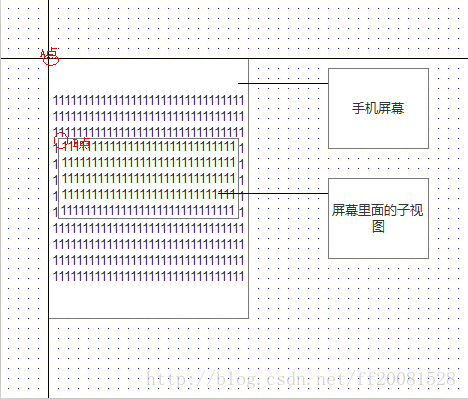
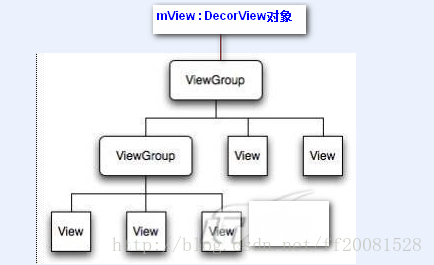
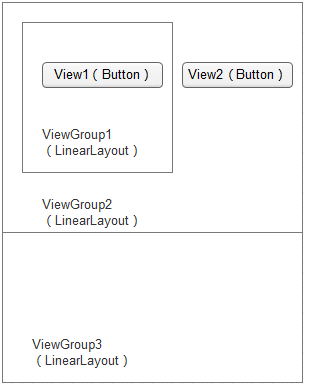
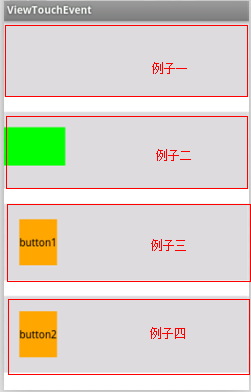



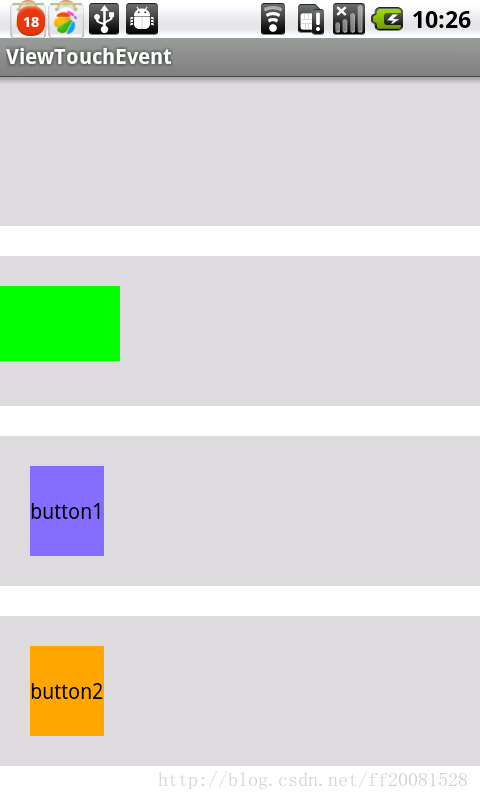














 329
329

 被折叠的 条评论
为什么被折叠?
被折叠的 条评论
为什么被折叠?








